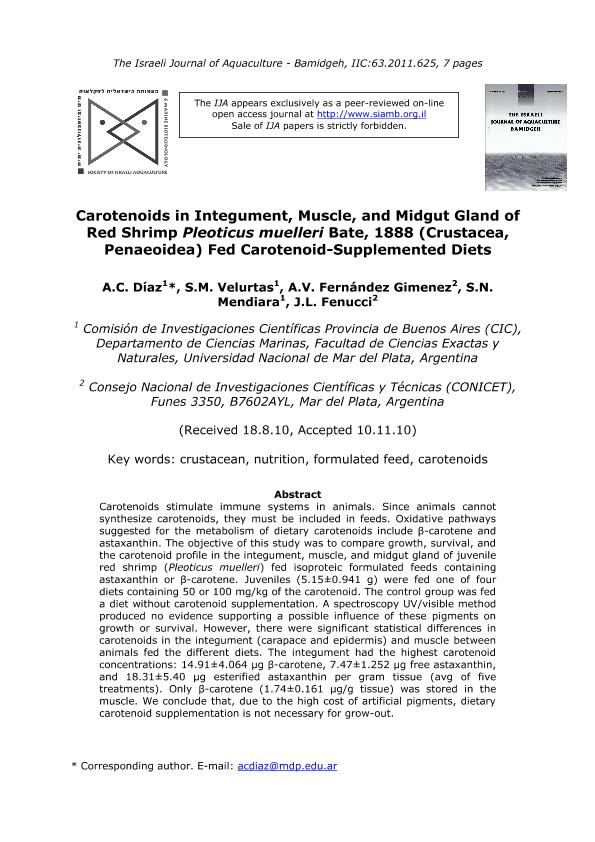Artículo
Carotenoids in Integument, Muscle, and Midgut Gland of Red Shrimp Pleoticus muelleri Bate, 1888 (Crustacea, Penaeoidea) Fed Carotenoid-Supplemented Diets
Díaz, Ana Cristina; Velurtas, Susana María; Fernandez Gimenez, Analia Veronica ; Mendiara, Sara Noemí; Fenucci, Jorge Lino
; Mendiara, Sara Noemí; Fenucci, Jorge Lino
 ; Mendiara, Sara Noemí; Fenucci, Jorge Lino
; Mendiara, Sara Noemí; Fenucci, Jorge Lino
Fecha de publicación:
08/2011
Editorial:
Society of Israeli Aquaculture and Marine Biotechnology (SIAMB)
Revista:
Israeli Journal Of Aquaculture-bamidgeh
ISSN:
0792-156X
Idioma:
Inglés
Tipo de recurso:
Artículo publicado
Clasificación temática:
Resumen
Carotenoids stimulate immune systems in animals. Since animals cannot synthesize carotenoids, they must be included in feeds. Oxidative pathways suggested for the metabolism of dietary carotenoids include β-carotene and astaxanthin. The objective of this study was to compare growth, survival, and the carotenoid profile in the integument, muscle, and midgut gland of juvenile red shrimp (Pleoticus muelleri) fed isoproteic formulated feeds containing astaxanthin or β-carotene. Juveniles (5.15±0.941 g) were fed one of four diets containing 50 or 100 mg/kg of the carotenoid. The control group was fed a diet without carotenoid supplementation. A spectroscopy UV/visible method produced no evidence supporting a possible influence of these pigments on growth or survival. However, there were significant statistical differences in carotenoids in the integument (carapace and epidermis) and muscle between animals fed the different diets. The integument had the highest carotenoid concentrations: 14.91±4.064 μg β-carotene, 7.47±1.252 μg free astaxanthin, and 18.31±5.40 μg esterified astaxanthin per gram tissue (avg of five treatments). Only β-carotene (1.74±0.161 μg/g tissue) was stored in the muscle. We conclude that, due to the high cost of artificial pigments, dietary carotenoid supplementation is not necessary for grow-out.
Palabras clave:
CAROTENOIDS
,
MUSCLE
,
MIDGUT GLAND
,
SHRIMP
Archivos asociados
Licencia
Identificadores
Colecciones
Articulos(IIMYC)
Articulos de INSTITUTO DE INVESTIGACIONES MARINAS Y COSTERAS
Articulos de INSTITUTO DE INVESTIGACIONES MARINAS Y COSTERAS
Citación
Díaz, Ana Cristina; Velurtas, Susana María; Fernandez Gimenez, Analia Veronica; Mendiara, Sara Noemí; Fenucci, Jorge Lino; Carotenoids in Integument, Muscle, and Midgut Gland of Red Shrimp Pleoticus muelleri Bate, 1888 (Crustacea, Penaeoidea) Fed Carotenoid-Supplemented Diets; Society of Israeli Aquaculture and Marine Biotechnology (SIAMB); Israeli Journal Of Aquaculture-bamidgeh; II; 63; 8-2011; 625-631
Compartir



